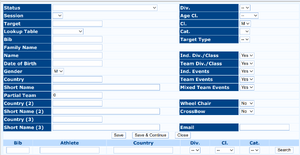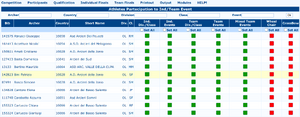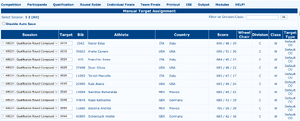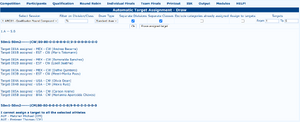Participants
This page is in progress Please check back later for additional changes. |
List (Simple)
This is the most commonly used list of participants. They can be added one by one manually or in bulk through the Bulk import page.
- Status: reflects the status of the participant
- Session: reflects the shooting session of the archer
- Target: shows the target assignment
- Bib: Bib/License number of the archer
- Local Bib: local ID of the participant. Usually empty, comes in handy if the list comes from an external source to check the coherence between the lists
- Family Name: Family Name of the participant. Mandatory field.
- Name: Given name. Can be left blank
- Email: Email, can be empty
- Accreditation Caption: overrides the generic accreditation caption for this participant
- Date of Birth: birthdate (in gregorian calendar). If present, the age class will be calculated based on this field.
- Gender: M (Male) or W (Female)
- Country: Country code (CIO 3 letter code) or Club Code
- Short Name: full name (abbreviated) of the club/country
- Wheel Chair: shows if the athlete will stay on the shooting line between waves
- Div.: Division
- Age Cl.: Age Class (real class) of the archer
- Cl.: Shooting Class of the archer
- Cat.: SubClass
- Target Type: Target selected for the archer. Usually filled in automatically from the available targets defined in the competition.
Add/Edit popup
To add a participant, click on :Add:. A popup will appear asking the details to be inserted. Ianseo allows up to 3 "club/countries" setup: this will be used in assigning archers to specific teams and produce ranking based on those club/countries.
- Status: eligibility of the participant at the date of the competition
- Session: shooting session
- Target: target assignment
- Lookup Table: lookup table (if any)
- Bib: license code, participant ID
- Family Name: family name. This item is mandatory.
- Name: given name
- Date of Birth: birthdate (used to calculate and filter the age class
- Gender: gender
- Country: Club/Country code. For countries use the IOC 3-letters country codes
- Short Name: club/country description
- Partial Team: eligibility for partial teams
- Country (2): second club/country code.
- Short Name (2): second club/country description
- Country (3): third club/country code.
- Short Name (3): third club/country description
- Div.: Division
- Age Cl.: Age class, calculated from the birthdate
- Cl.: shooting class. Can be different from the age class, depending on the ruleset used.
- Cat.: subclass, if defined
- Target Type: target type. Selected from the list of available targets defined according to the division and shooting class
- Ind. Div./Class: eligibility to be ranked by individual category
- Team Div./Class: eligibility to be ranked by team category
- Ind. Events: eligibility to participate to individual events (usually matches)
- Team Events: eligibility to participate to team events (usually matches)
- Mixed Team Events: eligibility to participate to mixed team events (usually matches)
- Wheel Chair: if set to yes, will allocate an empty slot on the other wave (in case of AB-CD waves) on the shooting line in case of automatic draw
- CrossBow: if set to yes, will allocate an empty spot on the same wave (in case of AB-CD waves)
- Email: email of the participant
At the very bottom of this popup, a list of fields can help searching for participants and filling up the upper fields based on the lookup tables. clicking on the code the data will be inserted (overwriting the existing ones if any).
Clicking on Save will save the participant and close the window. Save & Continue will save the data, clean the popup to insert another participant, while Close will close the popup discarding the changes.
Participant List (Advanced)
The Advanced Participant List will display a different view of the participants details, offering a filter bar and picture management. Some columns can be hidden to allow a more compact display: date of birth and gender (green), country 2 (red), country 3 (yellow) and category details (cyan).
Pictures (format is 4:3 portrait) can be uploaded from here: clicking on the picture image and selecting a file (jpg, png without transparency). The picture will be center-cropped to fit the 4:3 portrait format, removing left-right or top-bottom parts as necessary.
Adding a participant is achieved by pressing Add: an empty row will be shown ready to be filled. Inserting the license code in the "Bib" column will fill in the rest provided a lookup table has been loaded and set for that competition.
If a lookup table is there, the Search button allows a quick search to fill in the current row, eventually replacing existing data.
Athletes Participation to Ind/Team Event
This page shows and sets the participation to category ranking and events ranking in qualification and matches.
Athlete Status Management
Shows the list of athletes that are not eligible for participation or allowed to participate under certain conditions. If a lookup table exists it is important to synchronise it with the federal database in order to have the most recent numbers.
IRM Status Management
IRM is the acronym for Invalid Results Marks and is a way to mark certain athletes results:
- DNS: Did Not Start. This is the correct setting for athletes that for any reason could not start the competition phase. In case of matches, the opponent receives a bye and proceeds to the next match.
- DNF: Did Not Finish. Ianseo has 2 slightly different versions of this mark: regular and "no rank". The first one is the official one and means the athlete is ranked with that points and can eventually continue the competition. The second (No Rank) means the athlete is out of competition and will not be in the rank.
- DSQ: Disqualified. The athlete will lose its ranking position. If the disqualification happens during qualification, the team will also be affected if the athlete was part of a team. If a DSQ happens during the match, the archer loses the match, the opponent is granted or not a bye depending on the specific situation, but it does not affect team or qualification.
- DQB: Disqualified for unsportsmanlike behaviour. The most severe form of disqualification, usually after positive doping control. As this happens usually several days after the competition is over, this mark will affect all the athlete's result: they will be removed from the ranking lists as well as the team the archer as eventually a component.
Target
Target Assignment is an essential task in competition management. Theses pages are for Qualification only: for other stages of the competition please refer to the correct page.
Errors in the fields (overlapping target assignments) will be highlighted in red.
Manual Assignment
Manual assignment is pretty forward: for each athlete, you select the session and write the target position. Targets will be automatically left-padded with "0" and the letter automatically switched to uppercase.
Based on the number of archers per butt, you can assign up to the corresponding letter: if 4 archers per target letters are A-D, if 8 archers per target letters are A-H, etc. The maximum number of archers per target is 26 and maximum number of target is 999 per session.
Clicking on the Select Session number, the list only shows the not already assigned archers and the selected session.
A Division/Class filter is also available: wildcards are % (percent) to mean any sequence of characters and _ (underscore) to mean exactly one character.
Draw
The automatic draw is very powerful and assigns archers randomly on the defined targets, grouping them in ranges of targets by target type and distance. Each range can group archers by division, category.
Automatic draw will take care of leaving "vertical" or "horiziontal" free spots on the line based on the "Wheelchair" and "Crossbow" flags assigned to the archer.
The draw will try as much as possible to put people from the same club in adjacent targets depending on the draw type
- Select Session: from the dropdown select the session to work on
- Filter on Division/Class: only assign targets to the selected categories. As usual, % means any sequence of character and _ means exactly one character. So "&" will select everybody of that session, "R%" all the categories starting with "R", "_U21_" all under 21 categories, etc
- Draw Type:
- Standard Draw': starting from the biggest club (respect to the other filter options), the draw will assign archers from lower to highest target number, then the second biggest, etc.
- Field/3D Draw: same as previous, but the system skips a target between 2 archers of the same club to avoid "leaking" of unknown measurements information among club members.
- Oris Draw: Archers will be assigned setting after each big club a small club, in order to mix individuals inside clubs and not grouped all together at one end of the field
- Oris Draw 2: variation of the previous, starting the assignment from bot sides of the selected target range
- Separate Divisions: if more than one division is selected, this flag will group archers on the shooting line by division
- Separate Classes: same as above, for classes
- Exclude categories already assigned: this flag will not try to reallocate the already assigned positions
- Assign to Targets: until this flag is checked, all assignments are fictional, showing a simulation on how the assignments will be formed. As the assignment is random, the final result might not be the one shown on the previous dry-run.
- Targets: target range for the assignment.
Change Assigned Session
Based on the selectors, whole sessions can be moved to another session, eventually only the selected categories.
Move Target Assigned
This page allows to shift targets up or down inside the same session or move them in a different session.
Target Assignment by Rank
Assigns targets based on the current rank. Useful in certain competitions (Flights, Fields, 3D, etc)
Delete Target Assignment
Accreditation
This process is really important for the economic management of a competition. From this section, the user can manage not only prices and currencies, but also the actual participation status of athletes enrolled in the tournament, being promptly aware of participants that are attending the competition or not (meaning athletes that have already being accredited or not; see Figure 2.26).
[NB: Figure 2.26: Accreditation Management menu. !]
In the Accreditation management menu, the user will find the following items:
Accreditation: this item opens the main page in the Accreditation process. Based on the selected Session, it enables the user to shoot a picture for each participant, or to proceed in the athletes Accreditation Management and in the Equipment Inspection procedure (see Figure 2.27).
[NB: Figure 2.27: Accreditation Management options. !]
Clicking on Accreditation, the program opens a page showing all the athletes enrolled in the tournament. First of all, for ensuring that this option will work properly, the user has to click on Open Bill from the Accreditation main page, to set the tournament revenues counter to 0. Now, the system will add, to the initial value, the corresponding fees for each athlete that has completed the Accreditation procedure (for setting prices, see the following steps). To complete the Accreditation procedure for any athlete, the user can simply search him/her (manually, or using the search bar), and, then, click on the BIB number, opening a new window. Clicking on ‘OK’, the window will be automatically closed, and the Accreditation procedure will be, then, completed. If the system will return any error, the user can search the athlete and Cancel his/her Accreditation, by using the corresponding button, made available by the system right under the archer name.
Take Accreditation Picture
Through this option, the user can manage the parameters needed for shooting pictures for athletes that don’t have one in the official database (see Figure 2.28). When an athlete doesn’t have a picture in the system, the program returns an error, highlighting the corresponding row, as shown in the following picture.
[NB: Figure 2.28: Taking Athletes Pictures and system errors (Missing Photo). !]
Fees setup
the payment page displays only two drop-down menus and a box, where the user can type the tournament fees for every division and class combination (see Figure 2.29). As for the previous screens, by pressing and holding CTRL, the user can select more items at the same time. Once the selection is complete, the user can upload the fees into the system by clicking on the ‘Save’ button.
[NB: Figure 2.29: Setting the tournament fees. !]
Athlets fees status
As it can be easily understood, through this option, the user can manage athletes that, for several reasons, won’t have to pay for participating in the tournament. Searching and selecting these athletes from the drop-down menu, in the Payment page, the user can choose if any archer will have to pay the tournament fees (‘Yes’), or not (‘No’; see Figure 2.30). If any archer won’t have to pay these fees, the user will be able to edit the archers details as any other one, during the Accreditation procedure, with the only difference that tournament revenues won’t be changed accordingly.
[NB: Figure 2.30: Setting Nonpaying Archers. !]
Accreditation colors management
This function enables the user to manage colors for Accreditation badges, depending on the access rights granted to different participants classes (see Figure 2.31).









